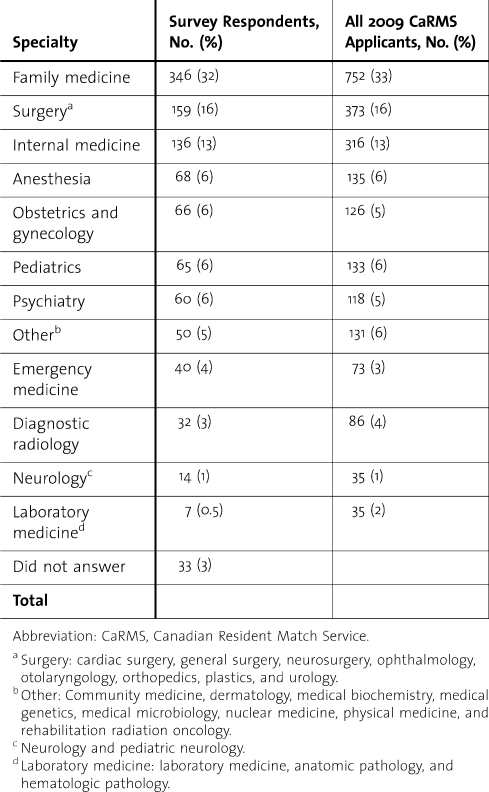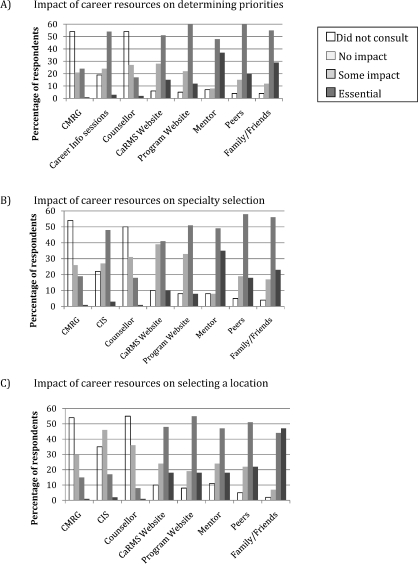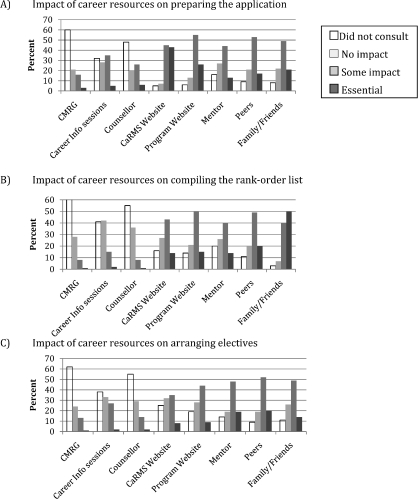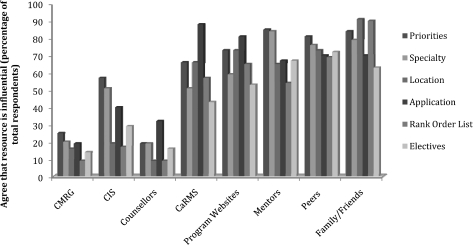Abstract
Background
Many medical students find choosing a residency challenging. There are several steps involved, including determining one's own priorities, arranging electives, choosing a training program and site, and preparing an in-depth application and a rank order list. Many resources are available to assist students, including the Canadian Resident Matching Service website, program websites, career counselors, career information sessions, mentors, peers, family/friends, and the Canadian Medical Residency Guide. Our study explored the relative impact of these resources on the career decision-making process.
Method
We invited medical students in their final year at 12 Canadian medical schools to complete an online survey. Questions included identifying the relative utility of resources in the context of each component of the decision-making process. Responses were analyzed using descriptive statistics.
Results
The response rate was 71% (1076 of 1518). Overall, mentors, family/friends, and peers had the most impact on students' decision making. Career counselors, websites, and the Canadian Medical Residency Guide had much less impact. Family/friends were most frequently cited as essential to the process; however, family/friends and peers were equal in having some impact.
Conclusions
Our findings suggest that students are most influenced by family, friends, and peers, who are not involved in the formal residency selection effort. Appreciating the impact of these influences on students' decision making is important to understanding how they decide on their future careers. The study supports continuation of mentorship programs. Future work could focus on qualitative research to further characterize resource use.
Editor's note: The online version of this article contains the survey instrument used in this study (952.9KB, pdf) .
Background
Choosing a specialty and location to pursue graduate medical education is one of the most difficult decisions faced by medical students. Despite the importance of this decision and the efforts supporting existing career resources, much of the existing literature focuses on improving recruitment to particular specialties, including the reasons applicants offer for choosing their specialty,1–12 and the efficacy of various recruitment strategies in attracting potential candidates.13–15 These studies provide valuable insight regarding students' choice of specialty and practice location, as well as insight to selection committees about the characteristics of successful applicants. However, relatively little is known about the utility and influence of resources offered to assist students in the process of selecting the clinical specialty as well as the program and institution for their training.
In Canada, there are 32 clinical specialties and 17 institutions across the nation for medical students to select for their post-MD training. Like their counterparts in the United States, Canadian applicants explore specialties and locations through independently arranged electives. The application process begins in the fall of the final year of medical school when students submit their applicant profile, personal letters, and letters of reference. After interviews, students submit a rank order list of programs in a given location. In 2009, applicants ranked an average of 10 training programs and 2 program specialties.16 The Canadian Resident Match Service (CaRMS) uses a computer algorithm to match the student and program rank order lists. Students check the CaRMS website in March and receive their contract-bound residency assignment.16
Students have several resources available to guide their decision making, including formal advice from career counselors and career information sessions organized at their schools, the CaRMS website and residency program websites, and the Canadian Medical Residency Guide, a student-developed resource with input from program directors nationwide. In addition to informal mentorship relationships, several formal mentorship programs have been organized by specialties, medical faculties, and professional organizations. A student's peers, family, and friends also influence the decision.
We conducted this national survey to explore the use and impact of career resources among all Canadian medical students in their final year after the 2009 CaRMS match.
Methods
Setting and Participants
Approximately one week after the match, we surveyed graduating students (N = 1518) from 12 schools representing large and small programs via Survey Monkey (Palo Alto, CA), and included schools from every English-speaking province. We sent 2 follow-up e-mails, and we closed the survey 4 weeks after the initial invitation. A small donation to the graduation fund at each school was made to encourage participation. The study received ethics approval from the University of British Colombia, the University of Toronto, the University of Western Ontario, McMaster University, Queen's University, the University of Ottawa, Memorial University, and Dalhousie University. Ethics approval at the University of Toronto was sufficient for the University of Calgary, the University of Alberta, the University of Saskatchewan, and the University of Manitoba.
Survey
The survey was developed with input from recent medical school graduates, third-year medical students, and 3 of the authors (S.B., C.L., and D.M.). After multiple revisions the survey was pilot tested among 6 recent medical school graduates (first-year residents on an internal medicine rotation). The final 16-question survey was divided into 3 sections: demographics (sex, medical school, and age at entry of medical school), career selection, and career resource use.
What was known
Many residency applicants agonize over specialty choice, which has implications beyond the level of the individual.
What is new
Canadian medical students reported that mentors, family/friends, and peers influenced their decision making.
Limitations
Potential for response bias, temporal influences on residency choice, and non-validated survey instrument 5 reduce generalizability.
Bottom line
In addition to individuals in medical education, residency selection is influenced by family, friends, and peers. Understanding how this shapes decision making 5 assist in optimizing choices.
The career selection section asked participants to indicate their first-ranked specialty and, using a 4-point Likert-type scale (1, “I thought it was a sure thing”; 2, “I thought I probably could get in”; 3, “I thought my chances weren't great, but not impossible”; and 4, “I thought it was close to impossible”), to indicate their confidence that they would match to their first-ranked specialty. Participants also indicated their level of certainty that they chose the right specialty on a 5-point Likert scale.
The career resource section asked respondents how influential available career resources were during various components of making their career decisions (ie, determining priorities, deciding on specialties, deciding on locations, electives, making a rank order list, and preparing applications). The resources listed were the Canadian Medical Residency Guide, career counselors, career information sessions, program websites, the CaRMS website, mentors, peers and family/friends. Students could rate each of these resources on a 4-point scale (1, “no impact on my decision”; 2, “some impact on my decision”; 3, “could not have made the decision without this resource”; and 4, “I didn't consult this resource”).
Responses were downloaded directly from Survey Monkey to Microsoft Excel (Redmond, WA). Duplicate and incomplete responses were removed before analysis. Descriptive statistics were calculated for all sections of the survey. Chi-square tests were performed to determine any potential correlations between career resource influence and sex, certainty, and confidence. A P value of .01 was chosen to correct for multiple comparisons.
Results
Demographics
A total of 71% (1076 of 1518) of invited participants completed the survey. The mean age at entrance to medical school was 24 years, and 52.8% (566 of 1076) of respondents were women, 46.3% (496 of 1076) were men, and 0.7% (7 of 1076) did not answer.
Career Selection
The table illustrates the breakdown of first-choice specialties of survey respondents compared with all Canadian graduates who applied to CaRMS in 2009.16
TABLE.
First-Choice Specialty of Survey Participants and Canadian Applicants
Certainty and Confidence in Career Choice
A total of 84% (902 of 1074) of respondents strongly agreed or agreed with the statement “I am certain I made the right career decision”, whereas 5% (56 of 1074) strongly disagreed.
A total of 66% (707 of 1075) of students responded they thought they “could probably get in” to their first-ranked specialty, 15% (159 of 1075) thought “it was a sure thing,” and 18% (191 of 1075) thought their chances “weren't great, but not impossible.”
Career Resource Use
A total of 74% of respondents agreed (60% [629 of 1057]) or strongly agreed (14% [187 of 1057]) with the statement “I had sufficient resources to make an informed decision,” with only 9% (97 of 1057) disagreeing or strongly disagreeing.
figures 1 and 2 summarize the influence of career resources on determining priorities, selecting a specialty, choosing a location, preparing the application, compiling the rank order list, and arranging electives. For ease of reporting, we renamed “could not have made decision without this resource” to “essential.” Overall, across all 6 components of the decision-making process studied, family/friends and peers were equally the most frequently cited resources to either have some impact or be essential to the decision-making process, whereas family/friends were most frequently cited as essential.
FIGURE 1.
Impact of Career Resources on (A) Determining Career Priorities, (B) Specialty Selection, and (C) Location Selection
The y-axis represents percentage of respondents. CMRG, Canadian Medical Residency Guide.
FIGURE 2.
Impact of Career Resources on (A) Application Preparation, (B) Compiling the Rank Order List, and (C) Arranging Electives
The y-axis represents percentage of respondents. CMRG, Canadian Medical Residency Guide.
We also analyzed influence by career resource. figure 3 shows the relative influence (combined impact of some influence and essential) for each career resource. Peers, Canadian Medical Residency Guide, and career information sessions were most frequently rated as having some or an essential influence on determining priorities (80% [839 of 1051], 57% [589 of 1051], and 25% [258 of 1051], respectively). The CaRMS website, program websites, and career counselors were most frequently influential in preparing the application (88% [915 of 1051], 81% [847 of 1051], and 32% [335 of 1051], respectively). Mentors had the most impact on determining priorities and deciding on a specialty (85% [897 of 1051] and 84% [888 of 1051], respectively). Students reported family/friends as having the most influence in determining location (90% [950 of 1051]) and preparing the rank order list (89% [935 of 1051]).
FIGURE 3.
Use and Relative Influence of Career Resources on Each Step of the Decision-Making Process
The y-axis represents percentage of respondents who stated the resource was at least somewhat influential.
There were no robust relationships between career resource use and confidence in students' career choices. However, after correcting for multiple comparisons, there was one significant association between resource use and career certainty: students who were influenced by their peers in preparing their application were more likely to agree they made the right career choice (χ2 = 10.22; P = .006).
Discussion
The literature on career decision making has explored what attracts applicants to given specialties and the personal attributes of successful candidates, with a focus on improving recruitment. However, little is known about how applicants obtain information and are influenced by career resources while making their career decisions. In this first nationwide survey of a representative sample of graduating medical students entering all specialties we described the influence of 8 resources on the career decision-making process.
Most participants agreed or strongly agreed that they chose the right specialty and were confident that they would match, which is reassuring given the perceived stress of the match. However, 5% (56 of 1076) of respondents strongly disagreed with their specialty selection, suggesting there is a subgroup of students that 5 benefit from further career exploration. The nature of this study did not allow for any exploration of reasons behind this, but a similar percentage (4.6%) did not match in the first iteration of the CaRMS process.
Students responded they had sufficient resources to make an informed career decision. Overall, we found that mentors, peers, and family/friends had a stronger than expected influence on all 6 components of the decision-making process.
The influential role of mentors on specialty selection is consistent with previous studies and adds to the existing support of mentorship programs.1,4,7,17–19 We also found that mentors influenced more than just specialty selection—they also had influence in helping students determine their priorities, choose electives, and select locations. In addition, this is the first study to our knowledge to demonstrate support for mentorship programs from the student perspective.
One study of psychiatry residents identified their involvement in a committed relationship as influential to program selection20; however, no previous studies have reported the magnitude of influence of family/friends as demonstrated in this study. This highlights a challenge for recruitment strategies because family/friends are relatively external to the formal CaRMS application process, yet they are the most frequently consulted and are most influential in a candidate's decision-making process. Theoretically, program directors recruiting students might benefit from knowing more about an applicant's personal life and relationships, but, ironically, the opposite usually occurs. During the application process program directors are not permitted to ask such questions.21 However, one recent study from a US medical school reported that 90% of students were asked a potentially discriminatory question, and in most cases students felt it did not affect their ranking of that specialty.22 More work is needed to determine the optimal balance between getting to know candidates on a personal level while avoiding potential discrimination.
The importance of the CaRMS and program websites in preparing the application was predictable given the essential information each provides. The influence of program websites on the rank order list suggests that it would be worthwhile for programs to continue developing and updating their websites to attract potential applicants.
When used, career counselors were most frequently influential (ie, having some impact or essential) in preparing the application. It is unclear why career counselors were relatively less influential than other resources. One possible explanation is that students 5 prefer advice from individuals who have gone through the match process themselves.
Overall, “person” resources were more influential than “information” resources. Personal relationships (mentors, peers, family/friends) were influential in all 6 components of the decision-making process. Applicants using this combination of resources are likely benefiting from advice from those who know them well: as a student with academic potential (mentors and peers) and those who understand their personality and life goals best (family/friends).
This study has several limitations. First, ratings of certainty and confidence 5 have differed in the weeks prior to the match. Second, we cannot identify any differences between responders and nonresponders, given the method of distribution of the survey. Third, the survey used was not formally validated. The survey focused on the impact of various career resources during the decision-making process, but we did not assess other factors that 5 have been influential, such as the interview process.
Our findings have several educational implications. This study highlights the importance of supporting current mentorship programs for undergraduate medical students. Initiatives to educate mentors about the scope of their influential roles should be implemented. Program websites and the CaRMS website are possible avenues to improve recruitment because these resources are highly influential in formation of the rank order list. The role of career counselors can be focused on preparing the application and supporting mentorship programs. Finally, the strong influence of people outside of the official scope of the graduate medical education programs creates a dilemma for program directors because these individuals and their input are highly influential on students' decision making, yet program directors are not permitted to inquire about them. This area requires further research to enhance our understanding of how to find the right balance among the factors that influence specialty and career decisions.
Conclusions
Our national study of Canadian medical students' residency selections identified personal supports (peers, mentors, and family/friends) as highly influential in all 6 components of the decision-making process. Family/friends and peers are relatively external to the influence of the selection committee. Our findings support the ongoing informal and formal mentorship programs that exist to help students choose their specialty. We also describe the potential for recruitment initiatives to capitalize on the influence of the CaRMS and program websites to affect applications and rank order lists. Further qualitative research is needed to characterize the nature of the influences that all resources have in the decision-making process.
Footnotes
Sarah Blissett, MD, is first-year resident in Medicine; she was a Medical Student at the University of Toronto, Toronto, Ontario, Canada, when the study began; at the time of writing, Christine Law, MD, was a medical student at the University of Toronto, and she is now a first-year Ophthalmology resident at Queen's University; Dante Morra, MD, MBA, is Associate Professor in the Department of Medicine, University of Toronto, Toronto, Ontario, Canada; and Shiphra Ginsburg, MD, MEd, is Associate Professor in the Department of Medicine, University of Toronto, Toronto, Ontario, Canada.
Funding: This study was funded by an unrestricted grant from the Royal Bank of Canada. The Royal Bank of Canada had no role in study design, analysis, or reporting.
We would like to thank Dr Carol Ann Courneya, Dr David Rayner, Dr Sylvain Coderre, Dr Shiela Harding, Dr Bruce Martin, Dr Susan Humphrey-Murto, Mr Mish Boutet, Dr Elaine Van Melle, Dr Albert Clark, Dr Michael Marrin, Dr Mark Goldszmidt, Dr Joyce Pickering, Ms Linda Purchase, and Dr Sharon Graham for their assistance in facilitating survey distribution and ethics approval at the study sites. We would like to thank Dr George Tomlinson for his assistance with statistical analysis.
References
- 1.Torrible S, Diachun L, Rolfson D, Dumbrell A, Hogan D. Improving recruitment into geriatric medicine in Canada: findings and recommendations from the geriatric recruitment issues study. J Am Geriatr Soc. 2006;54(9):1453–1462. doi: 10.1111/j.1532-5415.2006.00884.x. [DOI] [PubMed] [Google Scholar]
- 2.Maj L, Baerlocher M. Factors leading to radiology career selection: results of the 2004 National Physician Survey. Can Assoc Radiol J. 2006;57(3):175–178. [PubMed] [Google Scholar]
- 3.Marschall J, Karimuddin A. Decline in popularity of general surgery as a career choice in North America: review of postgraduate residency training selection in Canada, 1996–2001. World J Surg. 2003;27(3):249–252. doi: 10.1007/s00268-002-6642-8. [DOI] [PubMed] [Google Scholar]
- 4.Kolasinski S, Bass A, Kane-Wanger G, Libman B, Sandorfi N, Utset T. Subspecialty choice: why did you become a rheumatologist. Arthritis Rheum. 2007;57(8):1546–1551. doi: 10.1002/art.23100. [DOI] [PubMed] [Google Scholar]
- 5.Freed G, Dunham K, Jones MD, McGuinness G, Althouse L. General pediatrics resident perspectives on training decisions and career choice. Pediatrics. 2009;123((suppl 1)):S26–S30. doi: 10.1542/peds.2008-1578H. [DOI] [PubMed] [Google Scholar]
- 6.Eng MKH, Macneily A, Alden L. The urological personality: is it unique. Can J Urol. 2004;11(5):2401–2406. [PubMed] [Google Scholar]
- 7.Schwartz BS, Pransky G, Lashley D. Recruiting the occupational and environmental medicine physicians of the future: results of a survey of current residents. J Occup Environ Med. 1995;37(6):739–743. doi: 10.1097/00043764-199506000-00017. [DOI] [PubMed] [Google Scholar]
- 8.Rogers C, Gutowski K, Rio A, et al. Integrated plastic surgery residency applicant survey: characteristics of successful applicants and feedback about the interview process. Plast Reconstr Surg. 2009;123(5):1607–1617. doi: 10.1097/PRS.0b013e3181a075ea. [DOI] [PubMed] [Google Scholar]
- 9.Eidt JF. Analysis of the current applicant pool to vascular surgery: who are they and where do they come from. Semin Vasc Surg. 2006;19(4):172–179. doi: 10.1053/j.semvascsurg.2006.08.003. [DOI] [PubMed] [Google Scholar]
- 10.Crace P, Nounou J, Engel A, Welling R. Attracting medical students to surgical residency programs. Am Surg. 2006;72(6):485–490. [PubMed] [Google Scholar]
- 11.McCaffrey J. Medical student selection of otolaryngology-head and neck surgery as a specialty: influences and attitudes. Otolaryngol Head Neck Surg. 2005;133(6):825–830. doi: 10.1016/j.otohns.2005.07.042. [DOI] [PubMed] [Google Scholar]
- 12.Raymond M, Sokol R, Vontver L, Ginsburg K. Candid candidate comments: the relationship between residency program selection factors and match list placements from ranked applicants. Am J Obstet Gynecol. 2005;193(5):1842–1847. doi: 10.1016/j.ajog.2005.07.060. [DOI] [PubMed] [Google Scholar]
- 13.Barrett K, Mistry N, Hayter C, Poldre P, Henry M, Gardner S. The effectiveness of the Ivan H. Smith memorial studentships program on encouraging medical students to pursue a career in radiation oncology. J Cancer Educ. 2008;23(4):226–229. doi: 10.1080/08858190802432992. [DOI] [PubMed] [Google Scholar]
- 14.Kerr J, Seaton MB, Zimcik H, McCabe J, Feldman K. The impact of interest: how do family medicine interest groups influence medical students. Can Fam Physician. 2008;54(1):78–79. [PMC free article] [PubMed] [Google Scholar]
- 15.Penciner R. Emergency medicine preclerkship observerships: evaluation of a structured experience. CJEM. 2009;11(3):235–239. doi: 10.1017/s1481803500011258. [DOI] [PubMed] [Google Scholar]
- 16.Canadian Resident Matching Service. http://carms.ca/eng/index.shtml. Accessed 5 25, 2010. [Google Scholar]
- 17.Cochran A, Melby S, Neu5er L. An internet-based survey of factors influencing medical student selection of a general surgery career. Am J Surg. 2005;189(6):742–746. doi: 10.1016/j.amjsurg.2005.03.019. [DOI] [PubMed] [Google Scholar]
- 18.Thakur A, Fedorka P, Ko C, Buchmiller-Crair TL, Atkinson JB, Fonkalsrud EW. Impact of mentor guidance in surgical career selection. J Pediatr Surg. 2001;36(12):1802–1804. doi: 10.1053/jpsu.2001.28842. [DOI] [PubMed] [Google Scholar]
- 19.Wright S, Wong A, Newill C. The impact of role models on medical students. J Gen Intern Med. 1997;12(1):53–56. doi: 10.1046/j.1525-1497.1997.12109.x. [DOI] [PMC free article] [PubMed] [Google Scholar]
- 20.Leverette J, Massabki A, Peterson H. Factors affecting medical students' selection of Canadian psychiatric residency programs: part II-some contemporary issues. Can J Psychiatry. 1996;41(9):582–586. doi: 10.1177/070674379604100907. [DOI] [PubMed] [Google Scholar]
- 21.Canadian Resident Matching Service. Interview guideline. http://www.carms.ca/eng/faculty_int_guide_e.shtml. Accessed 9 8, 2011. [Google Scholar]
- 22.Santen SA, Davis KR, Brady DW, Hemphill RR. Potentially discriminatory questions during residency interviews: frequency and effects on residents' ranking of programs in the National Resident Matching Program. J Grad Med Educ. 2010;2(3):336–340. doi: 10.4300/JGME-D-10-00041.1. [DOI] [PMC free article] [PubMed] [Google Scholar]






